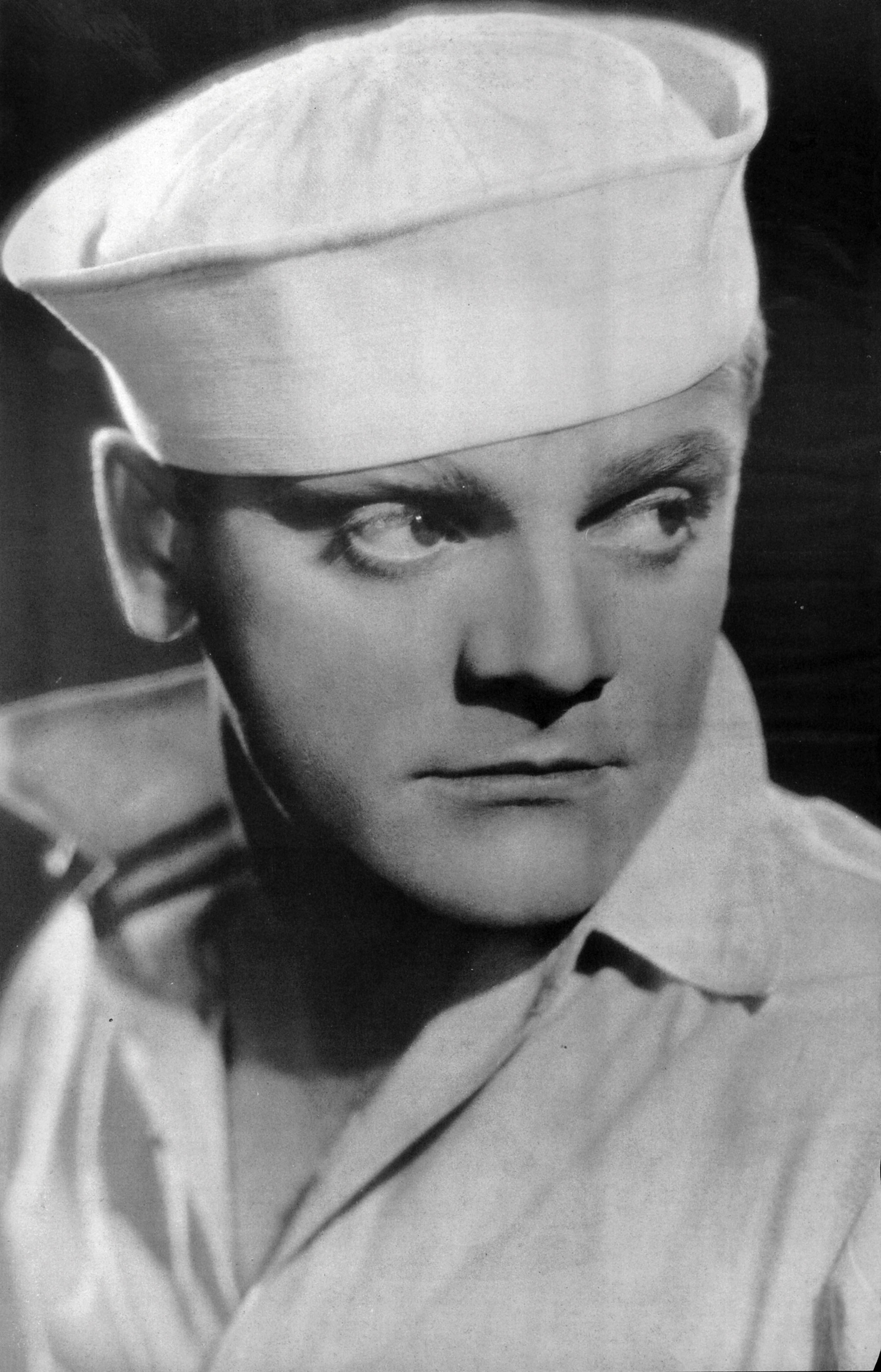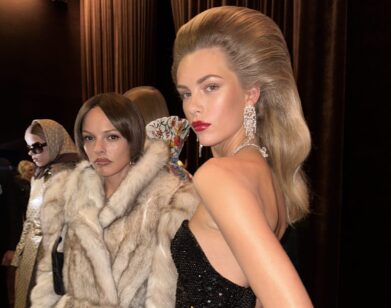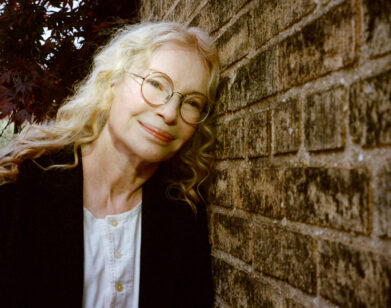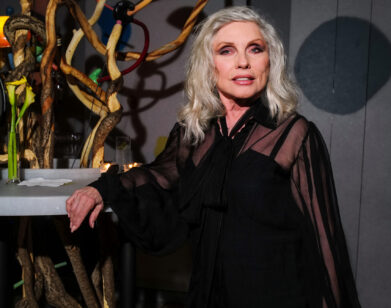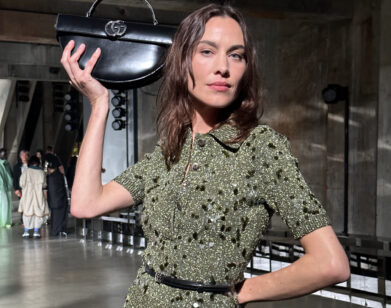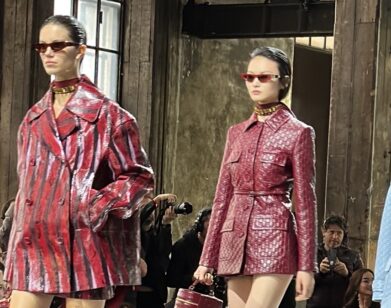Public Enemy turned patriotic icon: James Cagney on his legacy in film
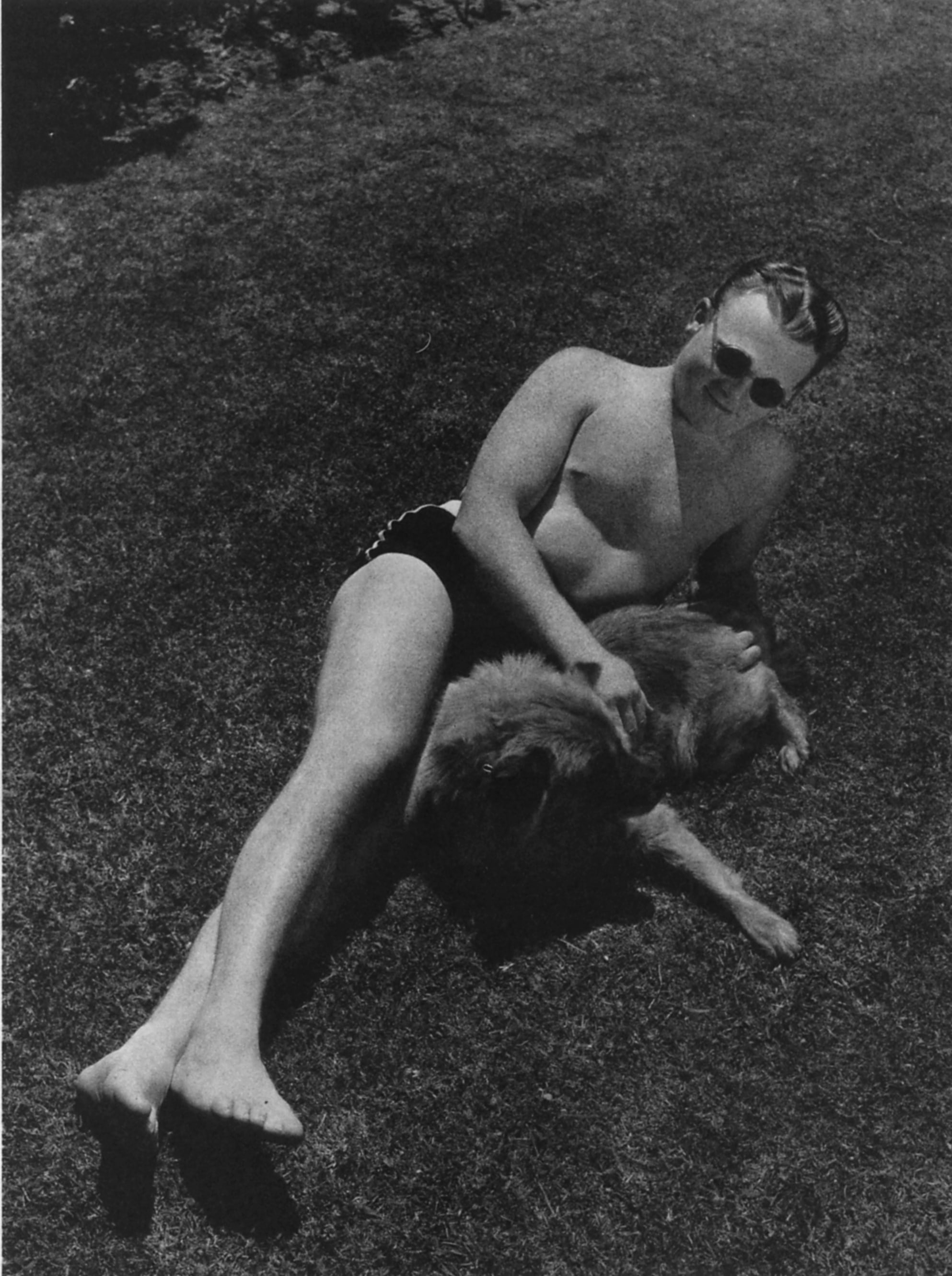
JAMES CAGNEY, AT HOME ON THE LAWN OF HIS FAVORITE POOCH AT HIS COLDWATER CANYON ESTATE, THE ONLY FARM IN TOWN. COURTESY OF HIS PERSONAL COLLECTION.
Amidst the waxing and waning legends in Hollywood’s pantheon, James Cagney is one of the true immortals. A veteran of nearly 70 films, many of them classics, he grinned, punched, danced and sang his way to the top. From portraying the denizens of the lurid underworld of crime and corruption, all the way to becoming the embodiment of American patriotism and showmanship, he brought an energy, good humor and cavalier grace to his work that even today seem breathtakingly original.
Born in New York City at the close of the last century, Jimmy Cagney soon found himself on Broadway making his mark in vaudeville. Success and recognition on the Great White Way led him, in 1930, out West to stardom during the Golden Age of Hollywood. With The Public Enemy (1931), he introduced a new persona to the world of cinema; the bad boy all America loved to hate, hated to love and couldn’t get enough of. He would go on to make many more unforgettable films during the Depression, such as Footlight Parade (1933), Jimmy the Gent (1934), A Midsummer Night’s Dream (1935) and The Roaring Twenties (1939), but it was his masterful performance as George M. Cohan in Yankee Doodle Dandy (1942) that revealed his unrivaled ability as an actor, singer and dancer.
In White Heat (1949), a classic study of derangement, Cagney painted a psychological portrait of the human as animal, while in Mister Roberts (1955), a satire on military authority, he portrayed the “heavy” with tongue-in-cheek authority. Having worked under many of the greatest directors and with an array of legendary co-stars for three decades, he retired from filmmaking in 1961, published his autobiography more than a decade later and returned to the screen as a cult figure of monumental proportions in Ragtime (1981).
I met with James Cagney in his hotel suite during his recent visit to Manhattan, and found him to be modest and kind, reluctant to say anything harsh about even the most notoriously impossible of his colleagues from the stage and screen.
GREGORY SPECK: Growing up in the rough-and-tumble world of turn-of-the-century New York City must have been colorful.
JAMES CAGNEY: It was basically no different than it is today. It was just everyday living. With me, it was fighting, more fighting and more fighting. Life then was simply the way it was: ordinary. Not bad, not good. No stress, no strain. Of course, no one had much of anything, but we didn’t know that we were poor. We certainly didn’t feel poor. My family lived mostly in a variety of tenement apartments in Yorkville on the Upper East Side, which at that point still had a lot of ethnic flavor: Irish, German, Czech, Hungarian, and so forth. One address I remember was 81st Street and York Avenue, where my father had a saloon. Yes, it was rough, and it was tough, but since I was a fighter, and a good one at that, it was not really so hard. For my brothers Harry and Eddie, though, who eventually became doctors, it was not so easy. They were athletic, but didn’t like to fight, so I had to stick up for them, which I was glad to do. My brother Bill, who became my Hollywood business manager, didn’t mind a fight either, so we made a pretty strong family. We stuck together. We had to, because it was a “knock ’em down, drag ’em out” kind of world. It built character and made us strong. It helped me later in Hollywood, too.
GS: Among your first acting jobs, you did female impersonations.
JC: Yes, I got a part as a chorus girl in a show called Every Sailor, and I had fun doing it. Mother didn’t approve of it, though. Of course, when you’re starting out, you do what you have to do to make a buck. It was basically just a job. You know, the period of World War I and the Roaring ’20s was really just about the same as today. You worked, and you made a living if you could and you tried to make the best of things. For an actor or a dancer, it was no different than today. It was a struggle.
GS: By 1920 you had landed a chorus-boy part on Broadway in a show called Pitter Patter.
JC: Yes, and it was fun to be singing and dancing in footlights, and be getting paid for it. It was exciting and brand new to me to be working in the Longacre Theatre. It was also the beginning for me of dancing before an audience, which always made me terribly nervous. I used to get butterflies in my stomach, and often threw up. But then, when I got out onto the stage, everything calmed down and I felt at home. Of course, those early attempts at dancing on the stage were immature, but the style of those early efforts became the pattern for the eccentric kind of dancing I did later on. I used it throughout my career, and, in fact, it became my trademark. Twenty years later, I used it to some acclaim in Yankee Doodle Dandy. Though I soon became typecast in Hollywood as a gangster and hoodlum, I was originally a dancer, an Irish hoofer, trained in vaudeville tap dance. It was also during the 1920s that I came into contact with Cary Grant. His real name was Archibald Leach, and he was part of a team called Parker, Rand, and Leach. He wanted out, so I replaced him, and we were known as Parker, Rand, and Cagney.
GS: How did you and your wife Frances meet?
JC: We met backstage during Pitter Patter. She had been part of a group known as Vernon and Nye, so she could dance, but I could not. She was also cute. I said “Hello,” and she said “Hello,” and that was the beginning of a love relationship that has spanned 63 years, and still exists today. Because her first name is Willard, I call her Willie, or Bill, for short. So as not to confuse her with my brother Bill, she is “My Bill.” If you want to call it love at first sight, then I guess that’s what it was.
GS: I believe that Al Jolson bought the rights to Penny Arcade and sold them to Warner Brothers, which led to your move to Hollywood to star in the film remake, entitled Sinners’ Holiday.
JC: It’s true that I went out West to Hollywood to act in the remake of the show, but not in any star capacity. I was just a guy doing a job, and Joan Blondell and I had only supporting roles. With the exception of the climate, Hollywood was really not much different from Broadway. The hours were long, and though it may have looked glamorous from the outside, on the inside it was hard work. We still had deadlines, and the same kind of script concerns, and we still were working with show business people, who are a special breed.
GS: In 1931, you created a sensation in The Public Enemy, directed by William Wellman.
JC: I don’t know about this sensation business, but The Public Enemy was the film that really launched my career. I played a mean, mixed-up hood, a tough kid who tried to throw his weight around and ended up dead. It was a good part. I don’t think I took anything away from it. It just kind of flowed along. As you may know, the first title was Beer and Blood. It was one of the first of many chances I had to portray that kind of person, the fist-swinging gangster who becomes ruthless in order to succeed. There were many tough guys to play in the scripts that Warner kept assigning me. Each of my subsequent roles in the hoodlum genre offered me the opportunity to inject something new, which I always tried to do. One could be funny, and the next one flat. A few roles among them were mean, and others were meaner. A few roles among them were actually sympathetic and kind-hearted, and I preferred them, but I generally did not get to do many of those parts until much later in my career, for the public seemed to prefer me as a bad guy. Since I was most frequently cast as a criminal, constantly on the prod, I rarely got to do the comedy roles I really would have preferred. I am really not at all like the character I played in The Public Enemy. I’m chiefly pretty quiet and reserved and private. Nevertheless, I had lots of gangster roles then, and in The Roaring Twenties and in White Heat, and too much of the same thing gets to be too much. I don’t understand why the public never tired of those awful hoodlums. William Wellman did a good job on The Public Enemy, I thought, as he did on the earlier picture I did with him, Other Men’s Women, in which I played opposite Joan Blondell and Mary Astor. He let me go my way and develop my own interpretation whenever it was possible. With other members of the cast of The Public Enemy, such as Jean Harlow and Joan, however, he was less understanding. Having this kind of discernment makes for a good director. It was he who suggested that I squash half a grapefruit into Mae Clarke’s face in the famous scene, and it set a precedent in the abuse of women in films. In my next film, Smart Money, which starred Edward G. Robinson, I again had to hit a lady in the face.
GS: How did the Depression affect your life in Hollywood as a contract player for Jack Warner, and eventually as his highest-paid star?
JC: The Depression really didn’t have any effect at all on my life, for I was under contract, and I had a job to do. For the first year, I was making around $500 a week, and turning out about five pictures a year. In 1931, after walking out on them after making Blonde Crazy, with Joan Blondell and Ray Milland, I found myself overnight making about $1,000 a week. Then, walking out again in 1932, after doing Winner Take All, I moved up into the league of Edward G. Robinson and Douglas Fairbanks, Jr., making $3,000 a week. Later still, in 1935, I walked out on Warner for breach of contract, when I saw that they were advertising a film of mine and giving Pat O’Brien top billing. It was Ceiling Zero, the sixth Cagney picture released in 1935, but my contract stipulated that they could only release four per year, and that in all of them I was to receive top billing. It gave me the leverage I needed to fight the studio, which no one had ever done before. I sued, and took off for Martha’s Vineyard for six months, which was the thing to do. When I won, I could pretty much dictate the terms of my contract. That kind of defiance later led to the fights Bette Davis, Olivia De Havilland and Miriam Hopkins waged against Warner. The studios were so rich and powerful, and so accustomed to exploiting their players, that everyone was astonished when I walked out. But my pictures were their biggest moneymakers, taking in millions. After I won, Jack Warner came courting me again, for his desire to make money was stronger than his pride. Finally, in 1938, Warner agreed to $150,000 per picture for me, plus a percentage of the profits. As for the Depression, we knew that it existed, but we were insulated from its effects. Since we had a demanding job to do, it was secondary to the task at hand, which was to learn my craft. We had to get to the studio early in the morning and make pictures all day long, seven days a week, twelve hours a day, often starting a new film the day after the previous one was finished, without any break at all. I did what had to be done—nothing more, nothing less. The old mogul system was not a good system, but it worked, and the so-called moguls weren’t good or bad, just doing their job, which was producing, just as I was doing mine. We all had families to support. Back then it was much easier to make a movie, for there was much more room and much less publicity. There seems to be a lot more money available today. People are paid $5 million to star in a piece of entertainment without much substance or character or message. The costs are unbelievable to me, but when you see 40 people stand around doing nothing for hours on end on a set and getting paid union scale, it’s no wonder that movies have gotten so expensive to make. That’s why we went to England to shoot Ragtime, at the Shepperton Studios outside London.
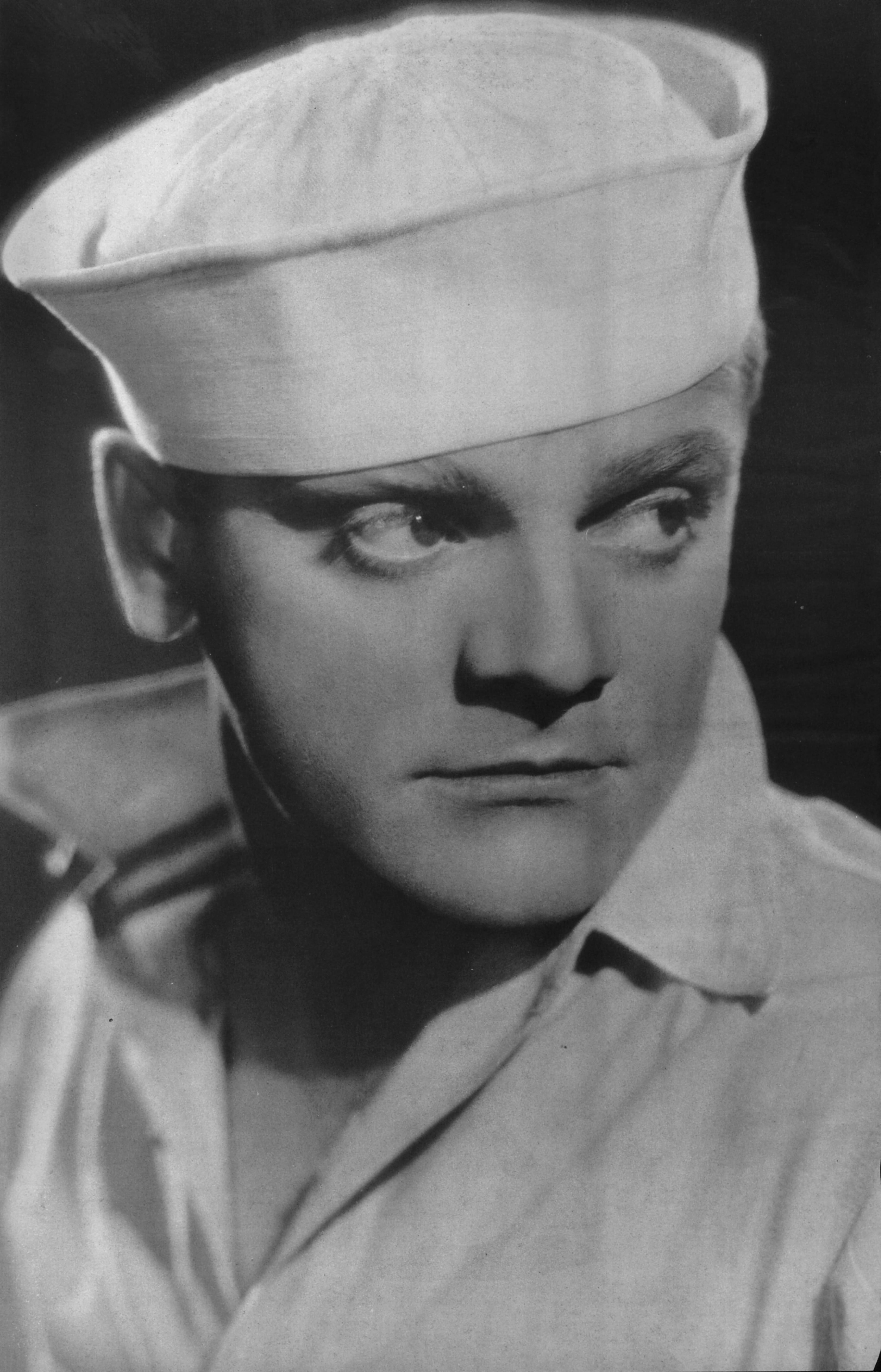
JIMMY CAGNEY IN “HERE COMES THE NAVY” (1934), IN WHICH HE CO-STARRED WITH HIS LONGTIME BUDDIES PAT O’BRIEN AND FRANK McHUGH. COURTESY OF HIS PERSONAL COLLECTION.
GS: In 1934 you played Jimmy the Gent with Bette Davis under Michael Curtiz. That film revealed your gift for comedy.
JC: It is true that Jimmy the Gent was my first film with comedic overtones. Very few people know this, but roles of that type were my favorites, and I always wished that they would give me more like them. With comedy it was possible to hoke it up. That was also the film where I showed up on the set with my hair all cut off in protest against the moviemaking conditions of the time. I had also gotten the makeup man to paint white scars all over the back of my head. I had a hell of a good time pulling that prank. When the camera picked up the scars, Curtiz almost had a Hungarian fit. I know that Bette Davis thought that I was a really tough guy, a rough character who beat up women, so she refused to be photographed with me for publicity stills. She seemed rather difficult to work with, from my point of view, but she did a good job in her part. I’ve said before that I thought she was a great actress, up there with Spencer Tracy, even though we didn’t get along. I later made The Bride Came C.O.D. with her, in 1941, and I worked with Curtiz twice more the following year, doing Captain of the Clouds and Yankee Doodle Dandy. I played a bad guy again, but it was a fairly straight part, and there wasn’t much to it. George Raft, though, was a very pleasant fellow and a good actor. Of course, he was truly a very tough man, who must have had some sort of association with the underworld of the time, which the rest of us did not, even though we were always playing thugs and hoods. I remember one incident in particular that happened on the set with Raft and Edward G. Robinson. Robinson liked to give directions to everyone all the time, and was something of a “know-it-all,” which made him difficult to take at times. Well, Robinson was giving his usual dictatorial instructions to Raft, and touched him on the arm to point him in a certain direction. Raft told him never to touch him again, but Robinson didn’t take heed to this warning. Shortly thereafter, he was telling Raft again what to do, and so he walked over to Raft to grab him by the arm and usher him to where he wanted him to stand. Raft belted him, and down went Robinson, halfway across the room. That was the last he told Raft what to do. Very few people realized it, but George Raft was one of the finest dancers in Hollywood, too. I rank him up there with Fred Astaire, he was that good. On only a couple of occasions was he allowed to show what he could do, and it was remarkable. Yankee Doodle Dandy, I was elected president of the Screen Actors’ Guild, during a time that accusations of leftist influence were being made about the film industry. The mob had targeted me for liquidation, and I was to have a klieg light dropped on my head when I walked onto the set. Well, Raft heard about the hit contract, and made a call to the right man, demanding that the plan be stopped, or they would have to answer to him. It worked.
GS: Raoul Walsh’s classic gangster thriller of 1939, The Roaring Twenties, paired you with Humphrey Bogart. What were those two legends like?
JC: If they were legends then, I didn’t know it. I got along fine with Walsh, for he took suggestions from me for script improvements and incorporated them into the scenes. I worked with him three more times, too, in Strawberry Blonde, made in 1941 with Olivia De Havilland and Rita Hayworth, in White Heat and in A Lion Is in the Streets, done in 1953. As for Bogey, he had a real presence as an actor, and he was able to do anything required of him. Oddly enough, I had killed him in the other two films I made with him also, Angels with Dirty Faces and The Oklahoma Kid. I never really got to know the man, however, but for that matter, few people did. He seemed to have an attitude that nobody was going to like him. The way he dealt with that was to be sure that they knew that he didn’t like them first. I’m not at all like that.
GS: Many people remember you best as George M. Cohan.
JC: Well, I could dance so I landed the part. It was my favorite role as the “all-American boy.” Hal Wallis, the producer, accepted my request to have final approval, so we went to work on the script and got it into shape. Then we prepared to shoot the movie. Cohan and I were about the same height, weight and build. Both of us had light hair, freckles and blue eyes, too, so in appearance we shared an Irish look. Same facial structure and features. Actually, we rewrote and reworked the script throughout the production. They now say Yankee Doodle Dandy is a classic. It had everything in it, as well as a good storyline and honest family relationships. Humor and some emotional impact were added along the way to round out the song and dance scenes. To arrive at the proper dance style, a friend was brought in to help. He was Johnny Boyle, who had worked on Cohan’s 1916 Broadway revue, and also on my 1937 film Something to Sing About. He knew the Cohan stiff-leg technique, and was able to teach it to me. All in all, it was a good movie. Not only was it well written and well acted but, most of it all, it had heart. As a matter of fact, I met Cohan once when I was still young. I was trying to get a larger part in a play of his, and he refused to advance me. In fact, he threw me out of the play altogether. But that didn’t bother me, for I know that he liked the film we made of his life. I made $850,000 doing Yankee Doodle Dandy; it was the highlight of my career.
GS: Back in the 1930s you were charged with Communist leanings. How did that happen?
JC: In 1935, I contributed to a fund to aid striking cotton pickers in California. It turned out that the organization responsible for collecting the contributions had left-wing leanings. I never knew that, or at least not until much later. The following year I donated again, this time to the defense of the Scottsboro Boys. If you recall, that was a case involving nine black men falsely accused of raping two white boys in Alabama. When the girls finally confessed that their testimony had been perjured, and admitted that the boys had done nothing to them, they were set free. But they had come close to being lynched. Well, the Communists took credit for raising the funds for their defense, and my name got tied up with the cause. Eventually, the Communists framed my check and hung it on the wall of their office in San Francisco. In any case, I never had any Communist leanings, nor any leanings toward any cause, other than liberty and freedom, which is what America is about. We have liberty and freedom only in the United States.
GS: Are there any people from your 65 years in and out of show business whom you particularly admired?
JC: Oh, my, yes. Many. I told you about Pat and Spencer. Well, I also liked Doris Day very much. She was a lovely girl and had a lot of talent. I made Love Me or Leave Me with her in 1955, and thought it was a shame that she went the route of Pillow Talk. Steve McQueen was another fine, fine actor, and a dear friend. What a shame that he died so young. You know, I knew many “stars,” but also liked being around the regular people, the crews on the sets. With them I could be myself, for they were street people, easy to be with, easy to know, easy to say things to.
GS: What advice would you give to someone just coming into the profession?
JC: Just walk in, plant your feet, look ’em in the eye and tell the truth. When you’re an actor, you go out on the stage, or the set, and you act. But if you’re a dancer, you’re everything, for you have to act and often sing when you’re dancing as well. I did all three. Luckily, I started to learn it at an early age, and I could make my body behave as I wanted it to. I learned everything I could when I was still young.
GS: You are also a poet, a painter and a yachtsman, I believe.
JC: Well, I get seasick a lot, but I love sailing. Once in 1978, out on Martha’s Vineyard, where I used to keep a place, I decided to take some guests out on my 42-foot ketch. We drove down to the dock, but the captain wasn’t there, so I piloted the boat myself, and it was wonderful. It helped me to recover somewhat from my illness. As for painting, I am often asked to sell my paintings. I always refuse, even though they sometimes offer me as much as $65,000. The reason is that I feel I would be depriving a struggling young artist of money he might be able to obtain for his work. I don’t regret not becoming a professional painter, though, for it all happened as it happened. I’ve always enjoyed painting, but the only way I part with my paintings is to give them away to charities, so they can be sold to benefit a cause I support. I still write poems, too, but used to do much more—humorous limericks, love verse and other things back in the old days. I wrote a poem for Willie Nelson the other night, too, to help him with his aid to the American farmer. The way I see it, we’ve done a benefit for Africa, so what about one for America? I think that the farmers in this country have gotten a raw deal. Many of them are unable to make ends meet, even as they work day and night. I know what a hard life it is, because I operate a farm in upstate New York, where we keep about 175 head of cattle. If I had to make a living farming, I’d be bankrupt.
GS: I know that you were always very close with your family, your parents and brothers and sisters, especially. Do you see the family institution collapsing today?
JC: What is happening is tragic, but I think that soon families will grow back together, for people need each other. The family is meant to make its members stronger by being together. I was regarded as the tent pole of my family by some, but I wanted to help them with my good fortune in any way I could. If the American family has seemed in danger of disintegration, I believe and hope it will survive, and I think America will return to the old values. That’s what Willie Nelson’s Farm Aid benefit concert and movement are all about.
GS: When are they going to do a film about your own life?
JC: Well, Misha Baryshnikov has been wanting to play me in a movie, but I told him that, with that accent, he wouldn’t be too convincing. He’s a great dancer, no question about it. Actually Treat Williams wanted to portray me as well, but the part is going to Michael J. Fox, who is such a talented young man. We get along real well, and I hope the film can be started while I’m still around to help with it. Some producers were trying to get John Travolta to play me, but even Travolta, who’s quite a fine actor and dancer, said, “What? Are you nuts?” He was the one who suggested Mike Fox, in fact. I keep my fingers crossed in the hope that it will all work out, because Mike is just about the first one who hasn’t been afraid to take on the role. But if I had the gumption to play George M. Cohan, then why shouldn’t young Fox play Jimmy Cagney?

